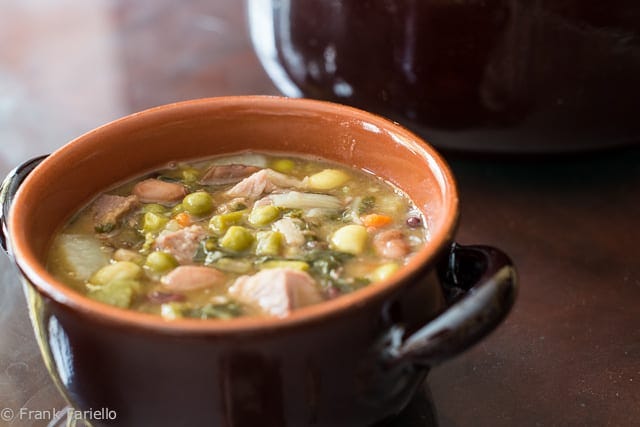Le virtù, literally meaning “the virtues”, is the signature Spring dish from the town of Teramo in the Abruzzo region of Italy. This version of minestrone takes it name from the Seven Virtues of Catholic catechism. Custom has it that you need 7 different legumes and 7 different vegetables to make it, plus, for the really hard-core traditionalist, 7 different meats, 7 different herbs and 7 different types of pasta, both dry and fresh. Some recipes take the metaphor even further, calling for 7 hours of cooking by—I kid you not— 7 virgins.
Well, if all of this sounds too elaborate for you, no worries. I may get myself into trouble with my friends from Abruzzo, but for today’s recipe, I’ve taken some liberties to come up with a recipe that should be manageable for most home cooks. The truth is, this minestrone started out as a culinary Spring cleaning, prepared once a year on May 1st, using all dried beans and other odds and ends that accumulated over the course of the winter, freshened with the first offerings of spring. So let me go out on a limb and say that the precise number of ingredients doesn’t really make that much difference—as long as there’s plenty of variety.
In its classic form le virtù is a hearty one-dish meal with all the basic food groups (including fruit, if you count the tomato). For this recipe, I’ve drastically cut the number and amounts of meat, so the dish can serve as a first course, and slightly simplified the technique. And, most heretical of all, I’ve skipped the pasta altogether, though feel free to add any short pasta, or mixed pastas, if you want a more substantial dish. One bit of esoterica I’ve kept is the pig’s foot, which provides meat, skin and a rich broth, all of which give the soup its characteristic taste and texture. But let’s call this optional. Pig’s foot isn’t common any more and not all that many people care for it. So if you want, skip the pig’s foot and use some extra pancetta instead.




